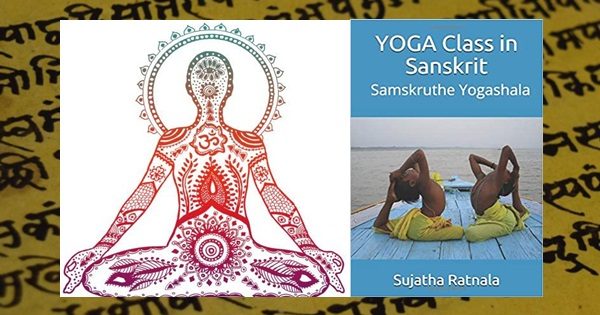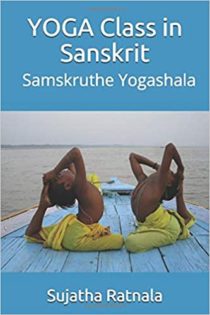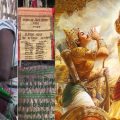Yoga Class in Sanskrit? Here Is How; An Interview

First of its kind, book Yoga Class in Sanskrit: Samskruthe Yogashala by Sujatha Ratnala provides a practical platform for conducting Yoga classes in Sanskrit in a gradual manner. It is aimed at Yoga schools, Yoga practitioners and instructors interested in learning Sanskrit. The medium of instruction is English and the Sanskrit vocabulary and scripts are in Devanagiri script.
As Yoga students, we come across Sanskrit all the time. Understanding and conversing in Sanskrit is a distant dream for many of us. This book brings together asana nomenclature, ancient quotes and shlokas, Yogic Folklore, vocabulary, language constructs, conversations and instructions all under one roof and in casual Sanskrit.
Ignite your passion, feel the vibrations and add a touch of Sanskrit to your Yoga practise!! Discover the language and Discover yourself.
The author of Yoga Class in Sanskrit: Samskruthe Yogashala Sujatha Ratnala is an engineer by profession, having worked in the embedded industry for about two decades now. Based in California, she writes on Mathematics, Technology, Linguistics, Yoga. As part of exploration and giving back, she has compiled this book assimilating her passion in teaching, Yoga, Sanskrit and ancient Indian Wisdom. She believes in reducing the complexity dimensions and hopes to see the Yoga community benefit from this work.
Here is an excerpt of an interview of Sujatha Ratnala that Uma Jagannath took for MyIndiaMyGlory. Uma Jagannath is a student of Sanskrit and Gita. An IT engineer, former researcher and a Yoga practitioner, her interests are in poetry, nature, wellness and heritage. She is based at California.
Uma Jagannath: Why Yoga teaching in Sanskrit?
Sujatha Ratnala: The source code that has introduced Yoga to us is all in Sanskrit. While the Patanjali Sutras, Gherenda Samhitha and the Hata Yoga Pradeepika outline the Yoga Practise, the philosophy of Yoga is expounded in the Upanishads, Yoga Vaasista, Bhagawad Gita and several other scriptures.
The sounds of Sanskrit and the emotions they stir need a mindset of contemplation and meditation. Yoga class in Sanskrit would provide a platform for the students to feel the vibrations and articulation of these sounds in a most organic way. From the known circle of Yoga towards the unknown territory of the language.
“Sanskrit is a divine language which beyond being spoken and written of course is a divine energy. It is as if it polishes that colourless crystal of the intellect. It therefore makes perfect sense to bring the yoga terminology together with spoken sanskrit to produce a framework for teaching asanas, pranayama and meditation. Ultimately yoga comprises of all eight limbs and the use of the energy of the sanskrit language as a tool in the Yogashala can only help to deepen the teacher’s and practitioner’s experience, to connect to that energy within themselves that is limitless, eternal and supreme. As time goes by students will find that their vocabulary has expanded effortlessly in a natural and progressive way. It is an inspired and comprehensive work which can be used in all levels of education and different yoga traditions according to their needs.” – Divya Prabha, B.A. & M.A (Oxford University), Shastri, Acharya & Research Scholar (SSVV), Co-founder, International Chandramauli Charitable Trust and Yoga Mission.
Uma Jagannath: Sanskrit is not an easy language. How does your book Yoga Class in Sanskrit: Samskruthe Yogashala attempt in integrating it?
Sujatha Ratnala: The typical method of language learning needs an acumen and focus for a steep journey. The idea is not to overwhelm the students with grammar and rules. The intent is to make the delivery effortless, interesting and integrate it with the Yoga class. Are n’t there times when we understand the most profound of the subjects by the articulation of the teacher? Like dharana, dhyana and samadhi like fixation with the sounds of the teacher.
For instance, after a month of Surya Namaskara practice, the language of the teacher does not really matter.. The key words and the body language are the cues. This is the perfect time to introduce a line or two in Sanskrit. And when the students keep listening day after day, they latch on to the vocabulary and the language.
“Learning of a language is deeper and easier when it happens unconsciously in the context of something else. In this book that something else is Yoga, which has a natural congruence with Sanskrit. The terminology of Yoga is in Sanskrit and it is natural that a student of Yoga would be interested in learning Sanskrit. Through words and sentences that would be commonly used in a Yoga class, this books gently introduces Sanskrit to the Yoga student in a way that is effortless and contextual and does not depend much on impartation of the explicit knowledge of grammar. It is interesting that there are so many aspects of the Sanskrit language such as verbs, adverbs, numbers, parts of the body, directions, names of animals and several other categories of nouns that can be taught in the context of a Yoga class”. – Vikram Gakhar, full-time engineer, part-time Sanskrit student/teacher/translator.
Uma Jagannath: Who is the book intended for?
Sujatha Ratnala: My book Yoga Class in Sanskrit: Samskruthe Yogashala is primarily intended for the Yoga teachers who have a fascination for the language. It assumes no prior knowledge of the language and provides a variety of lessons for facilitating the process. Vocabulary is introduced through picture cards. Reference scripts for all Yoga practices like Surya Namaskara, Meditation, Pranayama, different kinds of Deep Relaxation and Asanas have been provided.
Yoga Institutes especially those with the Sanskrit wing can include this in their short term and long term curriculum so that they can easily train the instructors with this knowledge.
Academic Institutes and Schools offering Yoga and Sanskrit can make language learning practical and interesting by adopting small sessions like Asana Names, Surya Namaskaras, Pranayama, Story Telling in the drill and cultural programs.
The department of Yoga and Culture can perhaps enable Airports and Museums with bilingual audios to arouse curiosity in the public in addition to special celebrations like International Day of Yoga.
“A novel concept to conduct Yoga classes in simple saṃskṛtaam. Now that Yoga classes are very popular, it introduces saṃskṛtaam to the common man in a very practical manner. This book is organized very well with minute details at every step and serves as an instructors’ manual. It also leads us back to our roots in Patanjali Yoga Sutras. It works both ways saṃskṛtaam through Yoga and Yoga through saṃskṛtaam. Great seva for saṃskṛti as well.” – Sarada Susarla, M.S, M.A. (Sanskrit), YIC.
Uma Jagannath: What inspired you to write Yoga Class in Sanskrit: Samskruthe Yogashala? Can you share your journey?
Sujatha Ratnala: I was learning Yoga in my apartment about 7 years back and I was totally in awe. A few students would find the Asana names difficult and I would attempt to break it to smaller words and explain. It reminded me of the taxonomy and classification concept in Biology.
Around the time, I attended a 10-day Sanskrit spoken workshop. I was very inspired and at the same time sad that the course was done. I had a whimsical thought “if only the Yoga class could fulfill my desire for hearing and learning Sanskrit on a day to day basis from the revered teacher.”
As an engineer, the leadership words echoed in my mind. “An idea is an idea no matter how small. Incubate and nourish it.”
I discussed this idea with Dr Nagaratna and Dr Nagendra of SVYASA if an expert could work on it.. Students like me would enjoy attending a class like this. Dr Nagaratna motivated me to fulfill this book as it was my vision.
My lack of language authority should not hinder me. I designed the chapters and filled in the Sanskrit as much as I knew. After a bit of scouting, there was grace and I got in touch with a Samskritha Bharathi scholar who helped in writing and editing the Sanskrit parts. It was a long journey indeed for the book to see the light of the day. And I am very thankful to my teachers, SVYASA, the volunteers and for this book review.
Uma Jagannath: That is an inspiring story. When did you first feel an immersion for Sanskrit?
Sujatha Ratnala: I was in middle school. Forget about Sanskrit, I barely understood hindi at that time. However there was something about the sounds that I could feel from within. The daily school prayers had a Rig Vedic song on Universal camaraderie.. Sangacchatwam.. We used to chant in unison Asatomaa, Poornam idam, Shan no mitrahah along with the regional songs. I did not care about the meaning or the language at that time. It is perhaps after 20 plus years I realised the significance of those lines and why I felt the fascination for the unknown words. I believe the repetitive sounds travel deep within us and makes a lasting experience.
Uma Jagannath: Returning back to your book Yoga Class in Sanskrit: Samskruthe Yogashala. How are people at different levels of familiarity with Sanskrit advised to use this book?
Sujatha Ratnala: This book provides a tool box of ideas to implement in a class. Depending on the ease and interest levels of the instructor and students, it can be used in parts or even improvised to fit the class style.
Yoga Class in Sanskrit: Samskruthe Yogashala is in English and the Sanskrit instructions are scripted in Devanagiri. All it needs is curiosity of giving this idea a thought.
– ASANA NAMES
– VOCABULARY BUILDING
– INFORMAL SCRIPTS
– FORMAL SCRIPTS
– QUOTES & YOGIC LORES.
The first chapter and a must read is about systematically understanding the Asana names. It breaks it down into categories such as body related, animal related, number related, direction related and through picture cards explains the various Asana names.
The chapter on short Yogic lores in Yoga Class in Sanskrit: Samskruthe Yogashala is an easy read too. A collection of stories on Patanjali, Yoga Vaasista, Pancha Kosha and parables from Rama Krishna that touch upon the path of self discovery. And a few other tales that connect to the Asana names.. Veerabhadra, Rajakapothasana.. This chapter gives an exposure to the breadth of Yoga texts and thereby introducing a variety of vocabulary and language structure and articulation.
The vocabulary chapter helps in getting started. Through picture cards and tables, there is introduction to human body parts, numbers, actions, adverbs and emotional nouns. The chapter on informal scripts is a fun way to converse in Sanskrit on topics outside and inside Yoga.
The formal scripts chapter attempts to cover the big gamut like Asanas, Surya Namaskaras, Pranayaama, Meditation, Deep Relaxation. For each module, it reiterates the key vocabulary and common phrases through pictures before jumping into the formal scripts. Thereby equipping the instructor to get comfortable with the scripts.
“More and more yoga students and teachers are seeking to recontextualise their practice in the tradition form which it comes. One way of doing that is to learn and use Sanskrit, from learning the names of the asanas to chanting shlokas. More and more are doing that, but few have taken the next logical step of creating a fully immersive Sanskrit environment for the practice of yoga. This book aims to help teachers easily create this Sanskrit environment for their students, in the process helping both teacher and pupil learn the basics of this beautiful ancient language.” – Venetia Kotamraju, Founder of Rasala Books.
Uma Jagannath: Does this book prescribe to a particular style?
Sujatha Ratnala: The SVYASA style of Yoga has been used as reference and inspiration for the scripts and the collection of Shlokas and Stories in my book Yoga Class in Sanskrit: Samskruthe Yogashala.
Uma Jagannath: Rough sketch on how to adopt Sanskrit one-hour yoga sessions in Sanskrit.
Sujatha Ratnala: This would depend largely on the interest and creativity of the teacher. Some lesson plans that I can suggest.
a) Adopt Sanskrit asana names instead of English. Chanting of Suryanamaskaara and Patanjali prayer.. For Suryanamaskaara, have the count in Sanskrit. These can be done from day 1.
b) In a few days, adopt a few lines to sequence the flow in the class.. This should be easy for the students as they understand the keywords.
नमोनमः greetings
ताडासने तिष्ठतु stand in tadasana
वज्रासने उपविशतु sit in vajrasana
शवासने शयनं करोतु lay down in shavasanaइदानीं सूर्यनमस्कारं कुर्मः let us now do Surya namaskara
पतञ्जलिश्लोकम् उच्चारयतु chant patanjali stotram
शुभदिनं भवतु have a good day.
c) The instructor may pick one practise that is close to her heart and use the script in simple form. Surya Namaskara, Deep meditation or Pranayama is a good choice. A very simple Kaphalabhati Pranayama script would look like this.
पद्मासने उपविशतु । Come to padmasana
नमस्कारमुद्रां धरतु । Adopt namaskara mudra
नेत्रं निमीलयतु । Close your eyes
प्राणायामश्लोकम् उच्चारयतु । Chant the pranayama shlokaचिन्मुद्रां धरतु । उदरं ध्यायतु । Adopt chin mudra.. focus on the abdomen
केवल-कुम्भकम् अनुभवतु । Experience kevala kumbhaka
d) Mark 3 days a month for Sanskrit immersion class for instance. Minimal talking in Sanskrit, observing silence and body language. Read out a Sanskrit story along with English.
e) Celebrate special events like International Yoga Day, Ratha Sapthami, Guru Purnima, Vyasa Jeyanthi with a bit of Sanskrit immersion. Chant Pratah Smaraami or Nirvaana Shatakam like bhajans.
f) Post the Sanskrit lesson plans and classes on Social media to celebrate and inspire other teachers and students with ideas..
“Yoga enthusiasts even with no idea about Sanskrit would feel like learning the language after reading this book. Good job! ” – Chandrika Sarapalli, Hayagreeva Yoga School, Bangalore.
Uma Jagannath: What is the way forward from here for a Yoga enthusiast to enhance their Sanskrit knowledge skills?
Sujatha Ratnala: They could take up a Sanskrit course if the focus is language. If the interest is on Scriptures, there are audio books and several lectures on Youtube. Vedantahub provides pointers to lectures. There are etymology groups in Facebook such as ‘Sanskrit the divine language’. Vande Mataram library Trust has opensourced the Vedas, Upanishads, Bhagawadgita and several texts in digital and audio format. Their Gita app is of great help with Sandhi breaks and phrase rearrangement. Upanishad stories are available in Simple Sanskrit.
Ramayana in Sanskrit video series is another great source to be tuned.
Sanskrit channel in YouTube has a collection of Sanskrit renditions with translation. Listening to Classical music and stotrams of Shankaracharya can open up newer dimensions as well.
Uma Jagannath: Can the book help in relating back to Patanjali Yoga sutras in a simple and organic way?
Sujatha Ratnala: Not exactly. Some of the core messages in the chapter on Yogic Lores are tied to the Patanjali Sutras. The book and its practice will give a sense of the language. And perhaps a sense of curiosity to discover other works.
Uma Jagannath: Does your book Yoga Class in Sanskrit: Samskruthe Yogashala also tie-in with other texts?
Sujatha Ratnala: The section on originals has a list of short maxims from the Upanishads, Bhagawad Gita and other scriptures. It has references to Yoga definitions, few Patanjali Sutras and shlokas from the Upanishads and Shanthi mantras. The Yogic Stories range from Upanishads, Puranas and Parables of Ramakrishna.
The quotations and stories presented in the book help the student get deeper into the theoretical aspects of the Yoga while at the same time getting more familiar with Sanskrit. This book with its convergent approach to Yoga and Sanskrit is unique and bridges a gap to exemplify the statement “युज्यते अनेन इति योगः” – Vikram Gakhar, full-time engineer, part-time Sanskrit student/teacher/translator.

Click here to buy Sujatha Ratnala’s book Yoga Class in Sanskrit: Samskruthe Yogashala.(Kindle editions are available in India; paperback editions are available outside India via Amazon).
Uma Jagannath: Thank you very much for the interview. What is your vision for the book?
Sujatha Ratnala: I would like this book to be used as a thinktank seedbank which can be improved upon by the Sanskrit scholars and the Yoga community. I hope to see a few teachers get inspired and add a little charm in their class. A Yoga school of tomorrow that opens up the doors of exploration and intuition.
Yoga is like a melting pot between the East and the West. Through Yoga and Sanskrit, one could have a glance of Indian Culture and ancient wisdom.
I get reminded of a prayer in school.
Takshshila, nalanda ka.. itihaas lautkar aaega
May the history of Takshashila and Nalanda return back..
Thank you very much for giving the author an opportunity to introduce the work.
Featured image courtesy: Hip & Healthy and Google.






